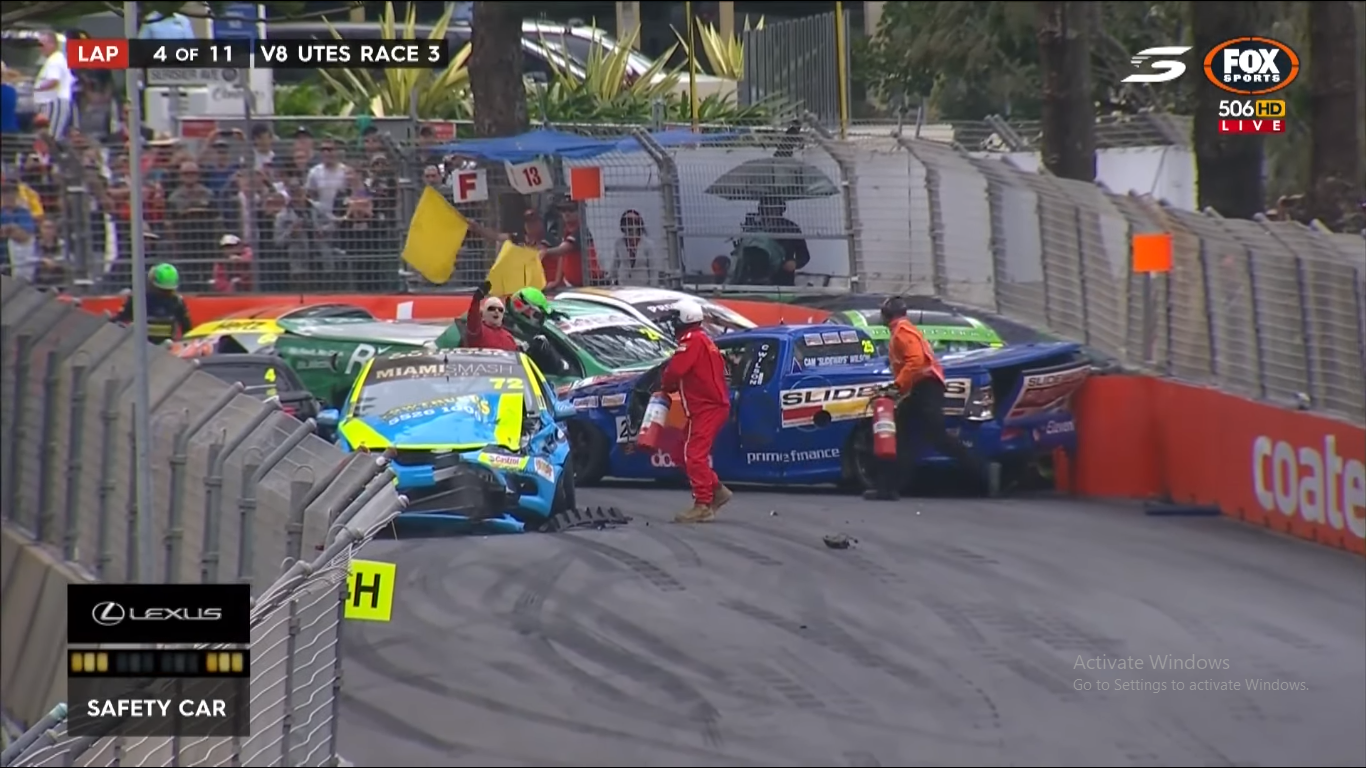
I’m the bloke in orange, in the middle near the yellow flags
Firstly, as a relatively new member of the club, I’d like to introduce myself. My name is Scott Long and my primary involvement in motorsport is as a volunteer Sector Marshal with Motorsport Australia. What is a Sector Marshal, you say? I’m glad you asked!
If you’re a driver, a sector marshal is the last person you want to see at a race track. If you’re face to face with a sector marshal, it usually means you’ve crashed and triggered a safety car or a red flag.
On the surface, it’s a very simple job. A sector marshal doesn’t appear to do anything unless there is an incident that would require racing to be neutralised. And even then, once we get the thumbs up from the driver and radio in the tow requirements, that’s job done. But scratch the surface, and it’s a lot more involved than that and it’s a position that holds quite a bit of responsibility.
On the hierarchy, a sector marshal is usually promoted through the ranks from a flag marshal and is the “manager” of a flag post. But despite the role being physically trackside role, race control regards a sector marshal as an Assistant Clerk Of The Course. Because of this, it is a senior role. So it is recommended the official has a Silver Circuit licence, or a Bronze Circuit licence at minimum.
Motorsport Australia’s position description of a sector marshal says, “a Sector Marshal manages and controls sections of the circuit and track, ensuring volunteer officials remain diligent to assigned duties in a safe environment and the management of racing incidents in their assigned sector.”
Essentially, we manage everything and everyone, on-track or trackside, within a designated part of the circuit which usually aligns with a flag post. From arranging recovery of a vehicle stranded on circuit, to being first-on-scene to a critical incident. From ensuring the flag marshals stay safe and healthy, to recommending certain marshals are part of succession planning programs. From ensuring photographers have the correct accreditation, to being judges of fact for on-track incidents. And everything in between. But let me go into some detail.
The top priority for every official is to look after health and safety of themselves, and their fellow officials. Part of the sector marshal’s job is to ensure that happens. We monitor water and food intake; reminding marshals to stay hydrated and take regular snack breaks. We monitor heat or cold exposure; reminding marshals to apply sunscreen, stay shaded when possible or the keep out of the cold winds in winter. We also manage fatigue; trying to encourage everyone to rest their legs and brain whenever they get the chance. Keeping our marshals safe and healthy ensures their best performance and it helps keep smiles on their faces.
The next priority is to ensure the safety of the drivers. That starts with constantly checking the track surface is free of debris or anything that can cause a lack of adhesion. We also intermittently monitor the performance of the flag marshals to ensure the correct flags are being displayed or waved, and remind, coach, or provide positive feedback when required.
We also need to be ready for if the proverbial hits the fan. Usually, after a major incident, the sector marshal will be the first person in attendance. Despite a million things going through your head once while the crash unfolds, you need wait for the incident to finish, then collect your thoughts. Once the crash has finished happening, you need to process what has happened, and what needs to happen next. Is a safety car or red flag required? Is the driver ok? Are all drivers involved ok? Is medical required? Is there fire? Will extrication equipment be required? Have marshals been injured? Have spectators been injured? Is it safe for me to enter the circuit to investigate further? Where are the rest of the cars on the circuit? Will I require help from other marshals? Will I need to direct traffic around the incident?
The ability to stay cool, calm and collected during this process can be make or break. Processing all this information quickly, is incredibly important. Then clearly and concisely relaying to race control what needs to happen next. Usually, there is some room for error. But if you have an incident like Roman Grosjean’s at the Bahrain Grand Prix, a few seconds of miscommunication or indecision can be the difference between a few minor burns and absolute tragedy.
So what’s the difference between that and what a communicator does? The main difference is a communicator tells race controls observations they’ve made. Its information only. Then race controls decides what to do with that information. Where a sector marshal, because they’re acting on behalf of the clerk of course, can make recommendations or requests based on the observations. For example, a communicator’s radio call could be “Car X has made heavy impact into a wall. Driver doesn’t appear to be moving”. The sector marshals call for the same incident would be “Car X, heavy impact into the wall. Recommend the session is suspended and requesting medical attend”
In a nutshell, that’s it! In perfect weekend, a sector marshal says nothing on the radio except for radio checks in the morning. And then sometimes, like what happened to me at the Gold Coast 600 in 2016, you get a 8 car pile-up in your sector and a blocked track! (Which is still my favourite race meeting to date).
If you’d like to know more, feel free to get in contact. Or simply talk our friends at The VFT!
Scott Long | Member #588
BMW Drivers Club Melbourne
Image provided by author.